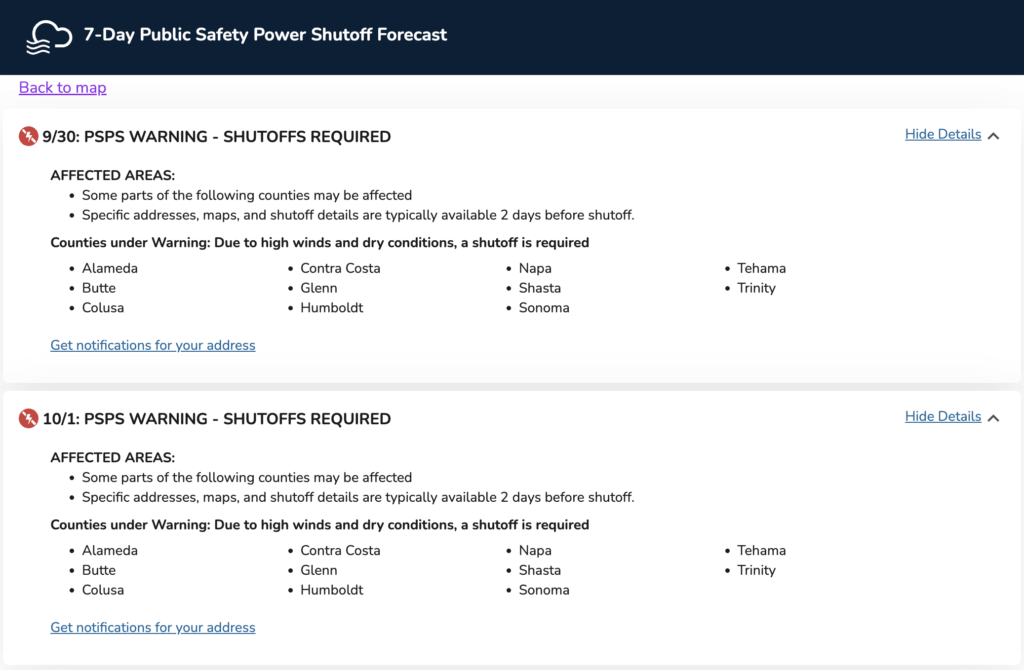Overview of PG&E’s Public Safety Power Shutoffs (PSPS) Program
PG&E’s Public Safety Power Shutoffs (PSPS) program is a critical initiative aimed at reducing the risk of wildfires in California. The program involves proactively shutting off power to specific areas during extreme weather conditions to prevent electrical equipment from sparking fires. While these measures are designed to protect public safety, they can also create significant challenges for residents and businesses in the Bay Area. How frequent are these shutoffs? More frequent than you’d think, especially in recent years. In fact, earlier today PG&E warned of potential power shutoffs throughout several Northern California and Bay Are Counties. View the PG&E Outage Map for more details.
Factors Leading to PSPS Events
Several factors contribute to the decision to initiate a PSPS event:
- Weather Conditions: High winds, low humidity, and dry vegetation increase the risk of wildfires.
- Field Observations: Real-time data from weather stations and field inspectors.
- Fire Threat Indices: Fire potential forecasts from local and national agencies.
- Operational Considerations: The presence of emergency services and critical infrastructure needs.
Michael Lewis, Senior Vice President of PG&E’s Electric Operations, explains, “Our primary goal with the PSPS program is to keep our communities safe from wildfires. We carefully monitor weather patterns and other factors to make informed decisions.”
Impact on Local Communities and Businesses in the Bay Area
The consequences of power shutoffs can be far-reaching, affecting:
- Residents: Disruption to daily life, including loss of refrigeration, lighting, and communication.
- Businesses: Financial losses due to operational downtime, spoilage of perishable goods, and reduced customer traffic.
- Public Services: Strain on emergency services and healthcare facilities.
Dr. Elizabeth Smith, Environmental Health Officer, highlights the public health implications, stating, “Power shutoffs can pose significant health risks, especially to vulnerable populations. It’s crucial for communities to have plans in place to mitigate these risks.”
Measures PG&E is Taking to Minimize PSPS Impact
PG&E has implemented several strategies to reduce the frequency and impact of PSPS events:
- Infrastructure Upgrades: Strengthening and modernizing the electrical grid with weather-resistant materials and advanced technology.
- Enhanced Monitoring: Installing more weather stations and high-definition cameras to improve situational awareness.
- Community Support: Providing backup power sources and resources to critical facilities.
A representative from the California Public Utilities Commission (CPUC) adds, “We are working closely with PG&E to ensure that they meet regulatory requirements and make meaningful improvements to the PSPS program.”
Tips for Customers to Prepare for and Cope with PSPS Events
Preparation is key to minimizing the inconvenience of power shutoffs. Here are some tips to help you get ready:
- Sign Up for Alerts: Ensure you receive timely notifications by signing up for PG&E alerts and notifications.
- Review Your Emergency Plan: Update your emergency preparedness plan to include provisions for power shutoffs, such as stocking up on non-perishable food and water.
- Backup Power: Consider investing in a generator or battery backup system for essential devices. Call or reach out to us today and let Solar Technologies provide a custom solution for battery backup to help keep your power on during unexpected and planned outages.
- Communication Plan: Have a plan for staying in touch with family and neighbors, especially if cell service is disrupted.
- Stay Informed: Follow PG&E’s updates and resources on their website and social media channels.
Community Support and Resources Available During Power Shutoffs
During a PSPS event, PG&E and various community organizations provide support to affected residents and businesses:
- Customer Resource Centers (CRCs): Locations where you can access charging stations, Wi-Fi, and basic supplies.
- Medical Baseline Program: Assistance for customers with medical equipment requiring power.
- Financial Aid: Programs to help offset the cost of generators and other preparedness measures.
Upcoming Developments and Changes to the PSPS Program
PG&E continues to refine the PSPS program with the goal of making it more effective and less disruptive:
- Improved Communication: Enhancing outreach efforts to provide clearer and more timely information to customers.
- Technological Advancements: Integrating machine learning and predictive analytics to better anticipate and respond to fire threats.
- Collaborative Efforts: Partnering with local governments and emergency services to develop comprehensive response plans.
Call to Action
By taking a few proactive steps, you can better prepare for and cope with PSPS events. Keep your lights on during outages with solar energy and a battery backup solution, leave your information below to get more information. Together, we can mitigate the impacts of power shutoffs and protect our communities from wildfire risks.

